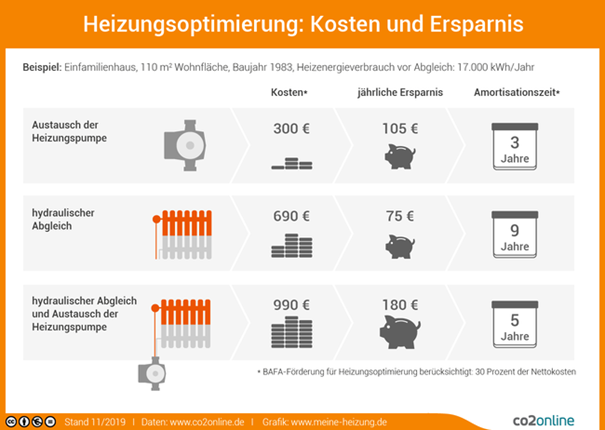What is hydraulic balancing? Procedure, benefits and costs explained easily
- what exactly is hydraulic balancing?
- how does the process work?
- advantages and costs
Hydraulic balancing is the final tuning of your heating system. It ensures that the pressure ratios of each radiator are optimally adjusted so that an optimum water supply can be guaranteed. By carrying out hydraulic balancing, an enormous amount of heating costs can be saved and living comfort is also increased. In most cases, the process takes no more than 6 hours.

What exactly is hydraulic balancing?
In a building, there are usually several radiators that are located at different distances from the heating source. Therefore, there are different physical conditions (pipe size, gravity, etc.) against which the heating water must pass in order to reach the radiator. However, since water always chooses the path of least resistance, there may be an under- or over-supply of water to the radiators. As a result, a considerable amount of energy is lost. Hydraulic balancing helps to solve this problem. The expert takes the data of your house. Furthermore, data such as air exchange, heat loss and the heating capacity of the individual radiators are included. Based on the determined structural situation, the specialist can now make adjustments to the radiators as well as the pump. The changes optimize the pressure prevailing in the individual sections as well as the flow temperature. This ensures better heat distribution in the individual radiators. Without hydraulic balancing, various problems can occur.
Signs of the need for hydraulic balancing.
The unwanted side effects of a poorly adjusted heating system may include the following:
- poor heat distribution in the radiators
- flow noise
- malfunctioning valves (too high or low temperatures)
- frequent switching on and off of the burner
- too high flow and return temperatures
Some of these signs are easy to detect, while others are difficult to check. If you suspect that you need a hydraulic balancing, do not hesitate to hire a professional to check it.

Procedure of the hydraulic balancing
In order for hydraulic balancing to be possible, certain requirements must be met. The heating system must have a two-pipe system and the radiators must have a return screw fitting or a thermostatic valve with presetting. It is easy to check whether a thermostatic valve has a presetting. Remove the thermostat from the valve. If there is a scale on the valve, it also has a presetting. In most cases, however, the flow valves must be replaced.

If these conditions are met, you can start collecting the necessary data. The presentation of the building plan makes the inspection much easier and more precise, because the more information is missing, the lower the effect of the hydraulic balancing. In summary, the following information is needed:
- size of the rooms
- heat output of the radiators
- distance of the radiators to the pump
- flow rate of the pump
- air exchange and heatloss through doors and windows
Based on these data, the heating load of the individual rooms is calculated. These values, in turn, are compared with the actual heating load of the radiators, whereupon one can optimize the setting of the valves and possibly throttle the flow temperature.
What are the benefits and costs of hydraulic balancing?
An immediately recognizable advantage of hydraulic balancing is the elimination of flow noise. Also, the improved heat distribution can be easily demonstrated by turning on all the radiators at the same time. They should now warm up at the same time. The selected temperature is now also maintained more evenly. Through these points, the living comfort increases immensely. But you also observe benefits behind the scenes. Your heating system now requires less energy which leads to a variety of benefits for you: First and foremost, you save money, protect the environment, and at the same time increase the value of your property. These are a whole range of benefits.
The cost of hydraulic balancing can vary widely, depending on the size of the house and the scope of the necessary adjustments. For example, you can expect to pay between €300 and €500 for the service alone. However, if you need to retrofit your thermostatic valves, the whole undertaking can be quite a bit more expensive.
Conclusion
Hydraulic balancing can save you a lot of money and increase your living comfort considerably. If you notice signs such as poor heat distribution or flow noises, it is definitely worthwhile to carry out this procedure. However, they should also note that their heating system must meet certain requirements. If all precautions are taken they can count on costs of approx. 60€ per radiator. However, the expenditure should pay off over time, due to the high savings potential.


